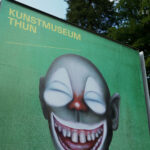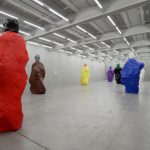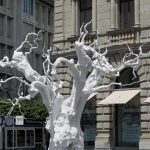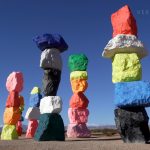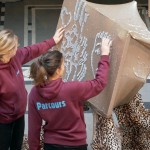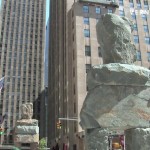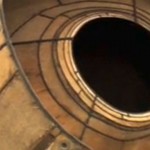Galerie Eva Presenhuber opens the fall season with a solo show by Swiss artist Ugo Rondinone. Last year, Rondinone had a comprehensive solo exhibition at Aargauer Kunsthaus. Galerie Eva Presenhuber presents three work groups: a series of bird figures, six huge ink paintings, and a group of text related works on scrap wood. In addition to these works, there’s also a clock made from stained glass with no fingers. It is cast into an outer wall of the gallery space and thus illuminated by daylight. The exhibition runs until October 29, 2011.
Ugo Rondinone: Kiss Now Kill Later. Opening reception at Galerie Eva Presenhuber, Zürich / Switzerland, September 1, 2011.
> Right-click (Mac: ctrl-click) this link to download Quicktime video file.
Excerpt from the press release:
The exhibition is designed in sequences: in each of the exhibition rooms, which are painted grey, three work groups are displayed, and recent works are combined with existing series. Amid these three work groups, one diminutive piece makes a distinctive appearance: a clock made from stained glass with no fingers, which is cast into the wall and is thus illuminated by daylight.
In the first room, we have a new body of work on display: a series of bird figures. A total of thirty bird sculptures have been installed across the whole of the exhibition space, as if in a flock. Created in various sizes, they are moulded in various positions and are all facing different directions. For the most part, these delicate sculptures do not exceed five inches in height and their characteristic claws, beaks and tails, though meticulously crafted, still manage to give of an air of casualness. Their appearance is that of birds, but their character is not. The titles of the bird sculptures refer to natural phenomena. In this way, they represent the natural world outside the artistic space. Their presentation within the group conveys the idea that those non-descript birds stand for more important events. The sculpture surface is covered with dense networks of fingerprints, which form stylised reliefs and mean that the work is forged entirely in the artist’s distinctive style, thus breaking the connection to real birds. The artist has borrowed this surface texture from his masks series. Like with these masks, the actual process of modelling the clay is visible since the artist’s fingerprints, created when moulding the clay, remain on the material after casting. In this way, the creation process is caught in time and is preserved in the finished sculpture. This moment is further emphasised by the materiality of these gracefully-formed figures: cast in bronze and installed on the floor, the creatures have been deprived of their most important feature: the ability to fly. This is compounded further through the artist’s choice of bronze as his work material. Its colour, too, is similar to the colour of the clay, something which that the artist considered as important in his choice of materials. The fact that the bronze was left raw and that the birds differ only in their finish, and not in the colouring of their would-be plumage, affirms this impression even more.
In the second exhibition room, six ten-foot by thirteen-foot ink paintings are hung on the walls. They feature Arcadian landscapes and forest paintings on large paper that has been stretched on canvas and mounted in a frame. They show drawings that are traditionally made in a sketchbook, with motifs reminiscent of the intimacy of 18th century cabinet pieces. Here, they are reproduced on a large scale, developed using a slide projector to enlarge miniatures. This is meant to allow the spectator to establish a direct physical relationship with them while at the same time empathising with their content. The large format has the effect of opening the spectator’s perspective on untouched landscapes and reflects an unaffected approach to idyl and nativeness. Their size means that they simulate the immediacy of a real experience for the spectator. The appearance of the ink drawings refers to the art form of calligraphy. This is because the artist is, in fact, working with a Chinese brush. The calligraphy symbols represent the movement of the artist’s hands and are comparable to the fingerprints on the bird sculptures.
The artist has been creating these monochromatic ink landscapes since the early 1990s. The collection is an as yet unfinished series that Rondinone has diligently worked on since his first solo exhibition, with Eva Presenhuber in Galerie Walcheturm in 1991. However, the most recent exhibition of these landscape drawings was held in 2002 at Sadie Coles HQ, London. There was therefore a strong desire for access to be granted to the public for this important body of work; one which the artist has previously described as the basis of all of his work, including his new drawings from 2011. When asked about his muse, Ugo Rondinone refers significantly to ‘Early Morning’, a small watercolour painting, measuring 7 x 9 inches and depicting a forest landscape in sepia, created by English artist Samuel Palmer in the year 1825. This is how the artist accounts for his choice: “A work of great spiritual power, it achieves and articulates a unique fusion of language, perception and visions. Its delicate touch plays on the texture richness that we find between the folds of very modest episodes, evoking a frisson of deep recognition, a sense of primal encounter with the brilliant, elusive world of senses. There is a striking freedom of style here, which allows the artist to move without any sense of strain or loss of balance from the visionary and ecstatic to the exquisitely precise. ‘Early Morning’ is an elegiac meditation on love, loss and the spiritual beauty of nature.” (in: domus 942, December 2010, p. 111)

